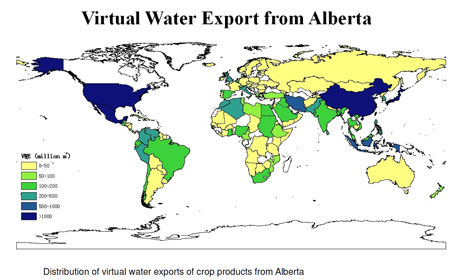Assessment of Virtual Water Flows in Alberta
Water scarcity has become more and more serious in Alberta. As a result, water-use challenges have emerged among agriculture, municipal, industrial and other water-intensive sectors. Under this background, the study aims at quantifying virtual water flows through the food trade in Alberta.
Virtual water is the amount of water that is embedded in food or other products needed for its production. To meet the challenge of gaining a better understanding and appreciation of our virtual water resources, the Alberta Water Research Institute commissioned Junguo Liu and Zhao Zeng of the School of Nature Conservation at Beijing Forestry University to:
- Quantify water footprint of major crops in a spatially explicit way
- Assess virtual water flows through the trade of major agricultural products
- Analyze the environmental effects of virtual water flows on other countries
Wheat, barley and canola are the most dominant crops in Alberta, together account for over three fourths of the total crop production. A GIS-based Environmental Policy Integrated Climate (GEPIC) model was used to quantify the water footprint of these three crops with a spatial resolution of 5 arc-minutes (around 10 km by 10 km, nearby the equator). Results show there is a relatively low water footprint of individual crops in regions with high precipitation or in the irrigation districts. At the provincial level, barley, wheat and canola had a water footprint of 699, 1635 and 2427 m3/ton, respectively.
On average, the virtual water exports of crop and livestock products were estimated to be 16.91 Gm3/year between the period 1999-2008. The average virtual water imports were only 0.85 Gm3/year. This results in average net virtual water exports of 16.06 Gm3/year.
On average, Alberta exported 5,083 m3 of virtual water (per person per year) through net food exports of crop and livestock products. This was almost 2.5 times higher than the average water footprint in Canada. Domestic production of crop and livestock products was mainly used for food exports to other countries. Wheat, beef and canola were the three major products contributing to net virtual water exports, and combined they accounted for over 99% of total net virtual water exports from Alberta.

Within Alberta, there is an increasing demand for water to support a growing economy and population, and to support our environment. In addition, relatively large amounts of water are being used to feed people throughout the world (through the export of food produced here in Alberta). As such, virtual water exports, future water and food trade policies have to be carefully developed, and incent new programs that promote improvement of water use efficiency, and also advance water use efficiency at a global level.
Contact us, if you have a question for Junguo Liu and Zhao Zeng on the report Virtual Water and Water Footprints.

